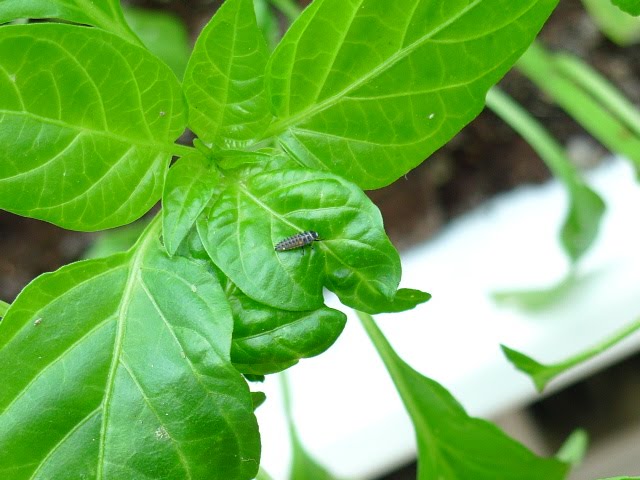Some of our plants are infected with aphids. These little buggers are vicious and they reproduce quicker than rabbits. We have tried diluted detergent on them but it didn't work. Just when we were losing hope, we saw some ladybirds in a bush on the way to the supermarket. We started collecting the ladybirds. We brought them home and placed them on the infected plants. Not all of them stayed. Some of the ladies didn't like this indoor garden to be their habitat so they left via the window. We now have a few ladybird warriors and they are doing us proud. This is a picture we took of one of our warriors ambushing an aphid. Watching them is like watching a 'live' documentary in your own home.
Here is another one of our warriors. Ladybirds feed on aphids, mites and everything pesty and not your greens. They are not poisonous to humans and do not post as a pest in your home. With the dam being so cold already, these warriors will soon start to move really slowly.
Some of our warriors are also reproducing and here is a baby ladybird on the leaf.
We love seeing a sight like this, black versus white. The black bugs are the ladybird babies and the white ones are the aphids.
Here are some facts from Wiki :
Most coccinellids are beneficial to gardeners in general, as they feed on aphids, scale insects, mealybugs, and mites throughout the winter. As in many insects, ladybugs in temperate regions enter diapause during the winter, so they often are among the first insects to appear in the spring. Some species (e.g., Hippodamia convergens) gather into groups and move to higher land, such as a mountain, to enter diapause.
Predatory ladybugs are usually found on plants where aphids or scale insects are, and they lay their eggs near their prey, to increase the likelihood the larvae will find the prey easily. Ladybugs are cosmopolitan in distribution, as are their prey.
Ladybugs also require a source of pollen for food and are attracted to specific types of plants. The most popular ones are any type of mustard plant, as well as other early blooming nectar and pollen sources, like buckwheat, coriander, red or crimson clover, and legumes like vetches, and also early aphid sources, such as bronze fennel, dill, coriander, caraway, angelica, tansy, yarrow, of the wild carrot family, Apiaceae. Other plants that also attract ladybugs include coreopsis, cosmos (especially the white ones), dandelions and scented geraniums.
Ladybugs are sensitive to most synthetic insecticides. If food sources are limited, oviposition is reduced. A larva uses its sharp jaws to crush an aphid's body and sucks out the aphid's juices.






No comments:
Post a Comment